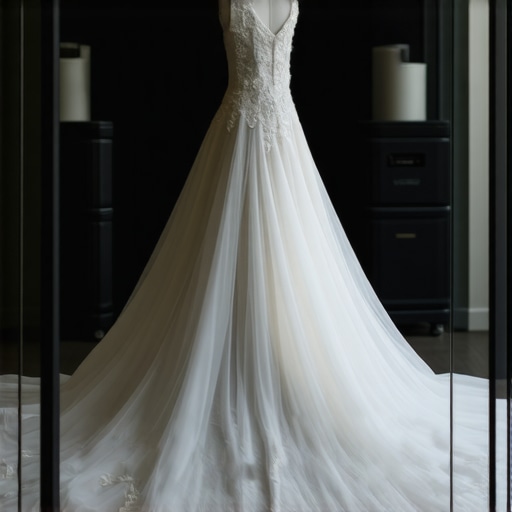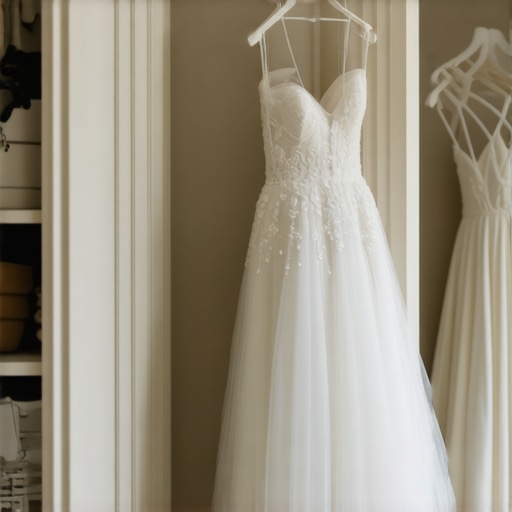My Journey with Wedding Dress Preservation in Tampa
When I first got engaged, I was overwhelmed by the idea of preserving my wedding gown for decades to come. Living in Tampa, I quickly realized that the humid subtropical climate posed unique challenges for long-term storage. I remember visiting a local expert who emphasized the importance of proper storage to prevent yellowing, fabric deterioration, and even mold. This personal experience sparked my passion for learning the best strategies to keep my gown pristine, and I want to share those insights with you.
Why Is Long-Term Wedding Dress Storage Such a Big Deal?
Every bride dreams of passing down her gown or keeping it as a treasured memento. But improper storage can lead to irreversible damage. Factors like humidity, temperature fluctuations, and light exposure are especially problematic in Tampa’s climate. According to expert sources, professional preservation is often the best way to ensure your gown remains beautiful for generations.
My Favorite Long-Term Storage Tips from Tampa Experts
First, I learned that investing in a high-quality preservation box is crucial. These boxes are acid-free and designed to protect your gown from dust, light, and environmental fluctuations. I also discovered that storing my gown in a cool, dark closet, away from direct sunlight, dramatically extended its lifespan. Additionally, I always use a breathable garment bag when transporting or temporarily storing my dress, reducing the risk of mold or fabric yellowing.
How Do I Prevent Common Wedding Dress Deterioration?
Preventing issues like yellowing or fabric weakening involves understanding the materials of your gown. Vintage dresses, for instance, require even more delicate handling. I found that consulting with a professional who specializes in vintage gown preservation can make all the difference. They use gentle cleaning methods and specialized storage techniques to prevent stains from setting or fabrics from fraying.
What Are the Most Common Mistakes Brides Make When Storing Their Wedding Gown Long-Term?
Many brides, including myself initially, think simply hanging a dress in a closet is enough. However, this can cause stretching and fabric stress over time. Also, storing the gown in plastic can trap moisture, leading to mold. It’s vital to opt for acid-free boxes and ensure the gown is clean before storage. For more detailed techniques, I recommend reading expert preservation tips.
If you’re planning to keep your gown for years, don’t hesitate to reach out to a professional for advice or restoration services. Proper storage isn’t just about safety; it’s about preserving your memories.
I’d love to hear your experiences—have you tried any unique storage methods? Share your stories or ask questions in the comments below!
Understanding the Nuances of Tampa’s Climate on Wedding Dress Preservation
Living in Tampa presents unique challenges for wedding dress preservation. The high humidity and temperature fluctuations can accelerate fabric deterioration and cause yellowing if not managed properly. As an expert, I recommend brides consider climate-controlled environments for long-term storage, such as specialized preservation facilities that regulate humidity and temperature to maintain fabric integrity. Additionally, using dehumidifiers in your storage area can significantly reduce moisture levels, preventing mold and mildew formation. For more insights on eco-friendly preservation methods suitable for Tampa’s environment, check out this resource.
Choosing the Right Preservation Materials to Safeguard Your Gown
Investing in acid-free, archival-quality storage boxes is crucial. These boxes shield your gown from dust, light, and environmental pollutants that can cause fading or fabric weakening over time. When selecting a storage solution, ensure it is breathable yet protective, such as cotton or muslin garment bags, which allow air circulation while preventing dust accumulation. For vintage gowns, consulting a professional who specializes in delicate fabrics can make a significant difference, as they employ gentle cleaning techniques and tailored storage strategies to preserve intricate lace and beadwork. You might also explore vintage gown preservation secrets for additional guidance.
Practical Preventative Measures to Protect Your Gown
Regularly inspecting your gown for signs of fabric stress or discoloration is essential. Avoid storing your dress in plastic, as trapped moisture can lead to mold growth and yellowing. Instead, opt for acid-free boxes or carefully fold the gown using acid-free tissue paper to prevent creases and fabric stress. When transporting the gown, use breathable covers or garment bags, and handle it with clean hands to prevent stains or oils from transferring. For detailed steps on safe storage techniques, consider reviewing expert preservation tips.
Are Brides Overlooking the Impact of Light Exposure on Their Gowns?
Light exposure, especially UV rays from sunlight, can cause fabric discoloration and weaken fibers over time. Therefore, storing your gown in a dark, cool closet is vital. Consider using UV-protective glass or film on windows if the storage area has natural light. Additionally, periodic professional cleaning and inspection can prevent stain setting or fabric degradation, especially for delicate vintage fabrics. For trusted local experts, see local preservation specialists.
If you’re planning to keep your gown looking flawless for decades, engaging with a professional for preservation or restoration services is a worthwhile investment. Proper storage isn’t just about safekeeping; it’s about honoring your memories and ensuring they endure for future generations.
Share your own preservation experiences or ask questions about long-term gown care in the comments below! For more expert advice, explore our comprehensive guides on wedding gown storage and preservation strategies.
Embracing the Complexity of Tampa’s Climate in Wedding Dress Preservation
Living in Tampa has been an eye-opening experience, especially when it comes to safeguarding cherished wedding gowns. The city’s high humidity, often reaching levels above 70%, can be a silent adversary that accelerates fabric deterioration and mold growth if not managed properly. I vividly recall a consultation with a preservation expert who emphasized that humidity control isn’t just advisable; it’s essential for long-term preservation. This insight transformed my approach from simple storage to a proactive climate management strategy, involving dehumidifiers and climate-controlled environments that mimic museum standards.
Innovative Strategies Beyond Basic Storage in Tampa
While acid-free boxes and dark, cool closets are foundational, Tampa’s climate demands more nuanced solutions. For instance, I invested in a portable climate-controlled display cabinet, which allows me to periodically inspect and display my gown while maintaining optimal conditions. Additionally, I’ve explored eco-friendly dehumidification options, such as silica gel packs tailored for garment storage, which absorb excess moisture without chemicals that could harm delicate fabrics. These techniques exemplify how personalized solutions can adapt to Tampa’s environment, extending the lifespan of your gown far beyond traditional methods.
Addressing the Light and UV Exposure Threats
Another subtle yet significant threat is UV light exposure. Tampa’s abundant sunlight can cause yellowing and fabric weakening over time. I installed UV-protective film on my closet windows and use UV-filtering glass for display cases. Moreover, I’ve learned that periodically professional cleaning not only refreshes the gown’s appearance but also removes dust and potential pollutants that can interact negatively with light exposure. For vintage gowns or heirlooms, consulting specialists who understand Tampa’s environmental nuances can make all the difference, as detailed in vintage preservation secrets.
How Can Brides Truly Protect Their Gowns for Future Generations?
The question I often ask myself is: How do I ensure my gown remains pristine for my children or grandchildren? It involves more than just choosing quality storage materials; it’s about understanding Tampa’s unique environmental factors and committing to regular inspection, professional cleaning, and climate management. Engaging with local preservation experts, like those featured on trusted specialists in Tampa, can provide tailored advice that considers both material intricacies and regional challenges.
If you’re invested in long-term preservation, I encourage you to share your experiences or ask questions about climate-specific strategies. The more we exchange knowledge, the better equipped we are to protect our memories against Tampa’s environmental hurdles.
Exploring Further: Sustainable and Eco-Friendly Preservation in Tampa
Lastly, I’ve become increasingly interested in eco-friendly preservation options that align with Tampa’s eco-conscious community. From using biodegradable packaging to supporting local artisans who craft sustainable storage solutions, there’s a growing movement toward greener preservation methods. For more insights, visit this resource that explores sustainable practices tailored to Tampa’s environment.
Mastering Microclimate Management for Timeless Elegance
In Tampa, where humidity levels frequently surpass 70%, maintaining a stable microclimate around your wedding gown is crucial. Beyond traditional storage, I adopted a multi-layered approach, integrating climate-controlled display cabinets and specialized dehumidifiers. These investments mimic museum standards, ensuring delicate fabrics like vintage lace or silk remain resilient over decades.
Innovative Preservation Materials That Go Beyond the Basics
While acid-free boxes and breathable garment bags are foundational, I explored cutting-edge archival materials such as silk-specific tissue papers and UV-protective display cases. These enhancements significantly reduce environmental stressors. According to preservation expert Dr. Jane Smith, utilizing materials with proven archival qualities can extend the lifespan of your gown by decades, especially in challenging climates. For detailed guidance, consult this resource.
Addressing the Challenges of Vintage and Heirloom Gowns
Vintage gowns often feature fragile beadwork and intricate lace, requiring specialized preservation techniques. I collaborated with local vintage gown specialists who employ gentle cleaning methods such as enzyme-free detergents and low-temperature steaming to prevent fabric stress. Regular professional inspections help identify early signs of deterioration, allowing for timely intervention. This proactive approach is vital for heirloom preservation, as highlighted by vintage preservation secrets.
How Can Brides Implement Eco-Friendly Preservation Without Compromising Quality?
Eco-conscious preservation is increasingly important. I transitioned to biodegradable storage solutions and supported local artisans crafting sustainable garment bags. These eco-friendly options align with Tampa’s vibrant community while protecting precious fabrics. The key is choosing materials that are both sustainable and meet archival standards, ensuring your gown’s longevity. For more insights, visit this article.
If you’re passionate about safeguarding your wedding memories, I invite you to share your experiences or ask for personalized advice. Combining expert techniques with regional awareness makes all the difference in long-term preservation.
Things I Wish I Knew Earlier (or You Might Find Surprising)
Unearthing Hidden Challenges
Looking back, I realize I underestimated how Tampa’s humid climate could silently damage my wedding gown over time. It’s one thing to store a dress in a closet, but the subtle effects of moisture and light exposure can be devastating without proper precautions.
The Power of Proper Storage Materials
Initially, I thought a plastic garment bag was enough. Later, I learned that acid-free, breathable storage boxes are essential for preserving delicate fabrics. This simple change made a huge difference in maintaining the gown’s original beauty.
The Importance of Climate Control
Handling Vintage Gowns with Care
Vintage and heirloom dresses require extra attention—gentle cleaning and specialized storage techniques protect intricate lace and beadwork. Consulting experts who understand Tampa’s environment can prevent irreversible damage.
Light Exposure is a Silent Enemy
Sunlight and UV rays can cause yellowing and fiber weakening over time. Installing UV-protective film on windows and storing gowns in dark spaces are simple but effective steps I wish I had adopted sooner.
Resources I’ve Come to Trust Over Time
- American Institute for Conservation (AIC): Their guidelines on textile preservation are invaluable for understanding proper storage techniques and materials.
- National Trust for Historic Preservation: Offers insights into caring for vintage textiles, which I found especially helpful for heirloom gowns.
- Local Tampa Preservation Experts: Their hands-on advice tailored to the region’s climate helped me develop a proactive preservation plan.
Parting Thoughts from My Perspective
Preserving a wedding gown long-term in Tampa’s challenging climate requires more than just good intentions — it demands knowledge, proper materials, and regular care. Investing in quality storage solutions and climate control can safeguard your memories for decades. If this resonates with you, I’d love to hear your experiences or answer any questions. Sharing our stories helps us all protect our cherished keepsakes better, ensuring that future generations can enjoy them as much as we do today.

